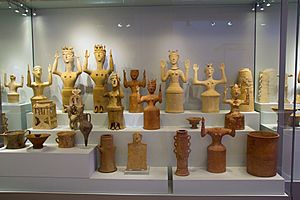Poppy goddess facts for kids
A famous ancient statue called the poppy goddess is a large clay figure from the Minoan art period. People believe it shows a goddess, but it was likely a votive offering (a gift to the gods), not a statue for worship. It was found in a special religious place at Gazi, Crete, dating back to 1400–1100 BC. Today, you can see it at the Heraklion Archaeological Museum.
The statue gets its name because it has shapes like poppy seed pods on its head, rising from a crown called a diadem. Other similar figures have different decorations on their heads, such as birds or the Horns of Consecration symbol. These figures have a round "skirt" that looks like a pot. This part was made on a potter's wheel. The upper body was then shaped by hand while the clay was still soft. Some figures even have tiny feet peeking out from under their skirts!
All these figures have their hands raised, usually with their palms facing sideways or outwards. There's often a hole at the top of the head, which might have helped the clay dry properly when it was fired. Small openings near the ears might suggest the goddess is ready to hear prayers. Most of these clay figures are not painted. They are related to other, less detailed, Minoan clay goddess figures.
During this time, the Mycenaean people had a strong influence on the island of Crete, especially in art. This shows that Crete had become part of the Mycenaean world after their invasion around 1450 BC. Unlike earlier times, these clay goddess figures were found in public religious places, not just in palace sanctuaries. Clay figures of a goddess with raised hands were also discovered in other important Minoan sites like the shrine of double axes in Knossos, and in Gournia, Myrtos, Gortys, and Prinias. The symbols on the heads of these figures include horns, diadems, birds, and poppy seeds. The female figure known as the poppy goddess might represent a goddess who brings sleep or even death.
The figures found at Gazi are larger than any other clay statues made in Minoan Crete before. They are made in a very simple and stylized way. Their bodies are stiff, their skirts are simple cylinders, and their poses are always the same.
Meaning of the Poppy Goddess
Experts believe that the raised hands of the poppy goddess figure, looking towards the viewer, mean that it is a goddess. The gesture of two raised hands with open palms might show an epiphany (a sudden appearance) of the goddess. It's possible the goddess is giving a greeting, a blessing, or is praying. It could also symbolize her appearing on Earth in human form.
Poppies were mentioned in ancient Greek and Roman myths as offerings to the dead. Some scholars, like Robert Graves, thought that the bright red color of poppies also symbolized the promise of coming back to life after death. He believed the poppy was a special symbol for the goddess Demeter. According to the ancient Greek poet Theocritus, Demeter was a poppy goddess who held sheaves (bundles of grain) and poppies in both hands.
Another scholar, Karl Kerenyi, suggested that poppies were linked to a special religious practice in Crete. He thought this practice was later passed on to the Eleusinian Mysteries, which were important religious ceremonies in Classical Greece.
Jane Ellen Harrison, another British expert on ancient Greece, agreed that the poppy reeds held by the figurine are connected to the "Mother of the Gods" in Minoan and Cretan beliefs.


